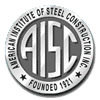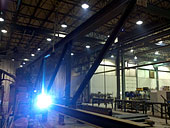About Steel Fabrication
Fabrication is a manufacturing process where bare, plain material is transformed into components (parts) of a building or other structure.
Only Steel?
Certainly not! While carbon steel is by far the material we work with the most, it is not the only material. Stainless steel and Aluminum projects are very common, especially for handrail and miscellaneous assemblies where intrinsic corrosion resistance is desired or will be used in harsh or sensitive environments such as chemical and wastewater treatment plants.
Receiving
Steel mills manufacture long, plain sections of material in a small set of shapes. Some of these shapes include:
- Angles
- I-Beams, usually of the modern wide flange variety.
- Channels
- Tubes - square and rectangular
- Pipes - round
- Bars - flat, square, and round
- Plates and sheets
These are received at the fabrication shop to be converted into parts and assemblies such as beams, columns, stairs, lintels, rails, equipment supports, or any other steel/metal structural component.
Cutting and Sizing
The first operation typically involves cutting these large, unfinished sections to the sizes needed for the parts or assembly being fabricated. Sawing, shearing, and plasma burning may be used to achieve the cut.
Drilling
Many assemblies require holes so that they may be bolted together with other assemblies to form the final structure. These holes are usually drilled mechanically using our CNC Drill Line or with a manual drill. Occasionally, however, holes may be formed by punching or plasma cutting, usually for small clips and parts or specialty plate parts.
Fitting
Fabricators lay out and mark how the parts are to be assembled or attached. Shop drawings, made by the detailing staff, are used to guide this process.
Welding
Welding is used to join and attach parts in assemblies where a strong, permanent connection is needed. Welded connections ensure that the connection is as strong as the base material itself. MIG (GMAW) is the most commonly used process in steel fabrication due to its ease of operation, high speed, and clean, slag-free welds. TIG (GTAW) welding may be used on specialty parts where a very high weld quality is needed, or for aluminum.
The welding operation is usually the center of the fabrication process, as it is the point where all of the parts and appurtenances are combined and joined into a finished assembly.
Finishing
In exposed architectural applications it is sometimes necessary to remove all mill scale and rust, grind down welds, and/or remove burrs from the assemblies. This is performed using wire brushes, abrasive grinding wheels, and sanding belts.
Painting
A basic gray "shop primer" is applied to nearly all assemblies in order to retard the formation of rust when steel is exposed to the weather during storage, transport, handling, and erection.
In some cases, we apply paint, epoxies, galvanization, or powder coating if needed by the customer. Specialty shops may be called upon to perform these operations to ensure a high-quality, contaminant-free coating.

